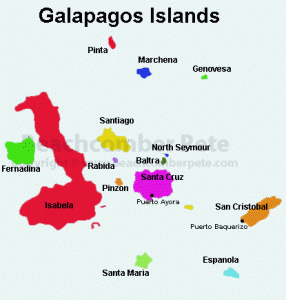One of the smallest islands in the archipelago known as the Galapagos Islands is the Baltra Island, also known as South Seymour. The traveler can find this island near the center of the Galapagos. Like the other islands in the area, Baltra was formed from various forms of lava and land movement and it is approximately two million years old. For many years, the Galapagos Islands only airport was on this island. However, an additional airport has now been built on San Cristobal Island. In spite of this, the majority of tourist flights continue to land at the Baltra airport. Because of this, most cruise ships meet their customers at this airport and start their itinerary on Baltra Island.
 It is interesting to note that Baltra Island has neither visitor sites nor accommodations for visitors. The available transportation is used only by those who come in by plane and need to reach their next mode of travel, either cruise ship or ferry. They will then be able to continue with their travels to the other islands.
It is interesting to note that Baltra Island has neither visitor sites nor accommodations for visitors. The available transportation is used only by those who come in by plane and need to reach their next mode of travel, either cruise ship or ferry. They will then be able to continue with their travels to the other islands.
Baltra’s history is a bit different from that of the other members of the Galapagos Islands. This island played a very important role during World War II. During this time, the U.S. Air Force set up a base on Baltra where they were joined by U.S. Navy patrols. Along with their submarine crews, their job was to keep watch for submarines in the waters of the Pacific Ocean, as well as to protect the Panama Canal. After the war ended, the base was handed over to Ecuador where it is now their official Naval Base. This is the reason that there are no visitor sites or accommodations on the island.
Baltra Island is a flat, dry island with few beaches. Volcanic cliffs surround most of the island. Like the other Galapagos Islands, the weather has two seasons. It has a hot season, which runs from December to May, and the dry season that runs from June to November. Although it looks desolate, there is some life to this island.
Because of the dry conditions, very few plants grow on Baltra. The only vegetation found there includes Prickly Pear cactus and Saltbushes. One may also find Opuntia cactus and Palo Santo trees. Other than these, there is very little vegetation.
When it comes to wildlife on the island, it is not so sparse. However, there are not nearly as many animals as can be found on the other islands. When the travelers arrive, they will be able to see birds such as the Galapagos Ground Finches, Frigate birds and brown pelicans. On the northern part of the island, one will find Mosaquera, which is a small sandy bank. It is here that a colony of sea lions can be found.
One very important animal connected with Baltra is the Baltra Land Iguana. In 1932-1933, some scientists removed 70 Land Iguanas from Baltra and took them to North Seymour Islet. Around the same time that the U.S. Air Force set up their base, the Land Iguanas native to Baltra became extinct. In 1980, some of the iguanas were taken from North Seymour Islet to Santa Cruz, where there was a captive breeding center for iguanas, the Charles Darwin Research Station. Luckily, they reproduced, and in 1991, some of these iguanas were returned to Baltra. As of 2007, there were 420 Baltra Land Iguanas living and breeding on the island. After landing at the airport on Baltra, the visitor can frequently see these iguanas near the runways.
As can be seen, Baltra Island is not as desolate as it may seem at first. Although it is not as open to the public as are the other islands, it still is a very important part of the Galapagos Islands. In addition to its importance in history, it is also the first island that most of the visitors walk on when traveling to this beautiful archipelago. When they arrive at the airport and see the Baltra Land Iguanas there to greet them, the travelers know that their trip to the Galapagos has just begun.






